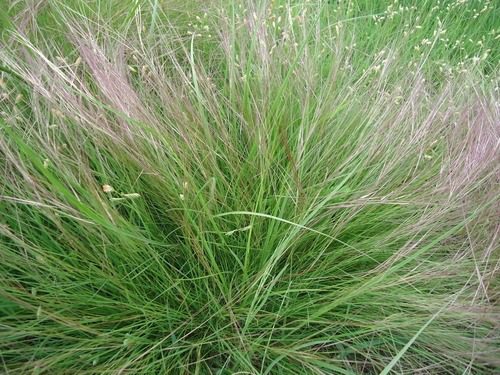Threeawn grass, or Aristida spp., is a genus of grasses commonly known as three-awns due to the characteristic three-branched awns (slender bristle-like appendages) that protrude from their seeds.
This genus belongs to the Poaceae family, which includes many grass species. Threeawn grasses are widespread, with various species found in North and South America, Africa, and Australia.
Threeawn grasses vary in size and appearance depending on the species. However, they generally have narrow leaves and distinctive seed heads with three long awns attached to the seeds. The awns often give the seed head a feathery or bristly appearance.
These grasses are typically found in a range of habitats, including grasslands, prairies, deserts, and disturbed areas. Some species are well-adapted to arid and semi-arid regions and are considered drought-tolerant.
Threeawn grasses play an essential role in their ecosystems. They provide forage for various wildlife species, including herbivores like grazing animals. The presence of threeawn grasses in grasslands can also influence the composition of plant communities.
The awns on the seeds of Threeawn grasses have a unique adaptation for dispersal. They can become twisted and attach to the fur or feathers of animals, allowing for wind or animal-mediated seed dispersal.
While some species of Threeawn are native and play a vital role in their ecosystems, there are also invasive species of Threeawn that can outcompete native vegetation in some regions, leading to concerns about their impact on local biodiversity.
In areas where Threeawn grasses are problematic invasive species, land managers may implement strategies to control their spread. This can involve grazing management, herbicide applications, and other control methods.
The genus Aristida includes a wide variety of species, each with its unique characteristics and ecological roles. Some of the common species include Aristida purpurea (purple threeawn), Aristida adscensionis (six-weeks threeawn), and Aristida longespica (slender threeawn), among others.
Threeawn grasses are an interesting group of grasses due to their adaptability to a range of environments and their unique seed dispersal mechanisms.
While some species have ecological importance, others can pose challenges in certain ecosystems. Understanding the specific species and their roles within a particular ecosystem is crucial for effective land management and conservation efforts.
Read Also: Texas Millet (Urochloa Texana) Growing and Care Guide
How To Grow Threeawn Grass (Aristida Spp.)
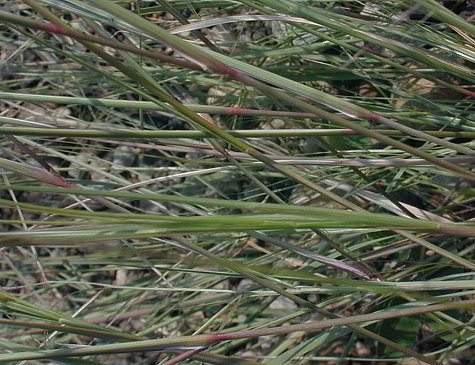
Growing Threeawn (Aristida spp.), a genus of native grasses known for their resilience and adaptability, can be a valuable addition to your landscape or restoration project. These grasses are particularly well-suited for arid and semi-arid regions.
Here’s a comprehensive guide on how to grow Threeawn grass in detail;
1. Choose the Right Species: Aristida is a diverse genus with numerous species. Select the species that are native to your region, as they will be best adapted to local conditions. Some common examples include Aristida purpurea (Purple Threeawn) and Aristida longiseta (Slimspike Threeawn).
2. Soil Preparation: Threeawn grasses are adapted to a range of soil types but thrive in well-drained, sandy or loamy soils. Before planting, prepare the soil by clearing away debris, rocks, and weeds. Consider amending the soil with organic matter to improve fertility and moisture retention.
3. Seed Selection: Threeawn grasses can be grown from seeds, which are widely available from native plant suppliers. Ensure you obtain locally sourced or native seeds to promote genetic diversity and adaptability.
4. Planting Time: The best time to plant Threeawn seeds is typically in the fall or early spring, when soil moisture is more reliable. Planting in cooler, moister conditions can enhance germination rates.
5. Seed Sowing: Spread the seeds evenly over the prepared soil. For larger areas, mechanical broadcast seeding or drilling may be more efficient. Cover the seeds lightly with soil or mulch to protect them from birds and wind.
6. Watering and Irrigation: After sowing, water the area thoroughly to ensure good seed-to-soil contact. During the establishment phase, consistent moisture is important for germination and early growth. Once established, Threeawn grasses are quite drought-tolerant.
7. Thinning and Spacing: Depending on the species, you may need to thin the seedlings to achieve the desired spacing. A spacing of 8-12 inches between plants is typically suitable, but it can vary based on your specific goals.
8. Maintenance: Threeawn grasses are low-maintenance once established. Periodic mowing or grazing, if appropriate for your site, can help control weeds and maintain the health of the grass stand.
9. Pruning and Weed Control: Regularly monitor for weeds and invasive species. Prune or control them to prevent competition with your Threeawn grasses.
10. Native Plant Considerations: Utilizing native grasses like Threeawn in your landscaping helps support local ecosystems and promotes biodiversity. Consider the ecological value of these grasses when planning your project.
11. Conservation and Land Restoration: Threeawn grasses are often used in land restoration and conservation efforts, especially in areas where native grasslands have been degraded or lost. Their adaptability makes them valuable for restoring native plant communities.
12. Wildlife Benefits: Threeawn grasses provide habitat and food for a variety of wildlife, including birds, insects, and small mammals. By cultivating these grasses, you can contribute to the ecological balance of your landscape.
13. Education and Outreach: Consider using Threeawn grasses as educational tools in school gardens, conservation projects, and nature reserves to teach others about the importance of native plant species in habitat restoration.
How To Care For Threeawn Grass (Aristida Spp.)
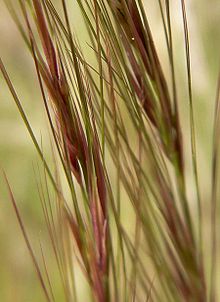
Caring for Threeawn (Aristida spp.), a type of grass commonly found in dry and arid regions, requires specific attention to its growth habits and environmental needs. This grass has adapted to survive in harsh conditions, and proper care can help it thrive.
Here’s a detailed guide on how to care for Threeawn grass;
1. Soil and Location: Threeawn grasses are well-suited to arid and semi-arid environments. They prefer well-drained, sandy or loamy soils. Plant them in an area that receives full sunlight, as they are typically sun-loving plants.
2. Watering: Once established, Threeawn grasses are drought-tolerant and require minimal watering. Overwatering can be detrimental to their health. Water them sparingly, providing moisture only when the soil is dry to the touch.
3. Pruning and Maintenance: Threeawn grasses typically grow in clumps and produce seed heads on tall, slender stems. To encourage new growth and maintain a neat appearance, prune the grasses in late winter or early spring by cutting back the dead or untidy stems.
4. Fertilization: These grasses are adapted to low-nutrient soils and do not require heavy fertilization. In fact, excessive fertilization can lead to leggy growth. If necessary, a light application of a balanced, slow-release fertilizer in the spring can provide adequate nutrients.
5. Pest and Disease Management: Threeawn grasses are relatively resistant to common pests and diseases. However, occasionally, they may face issues with grasshoppers or aphids. Monitor for these pests and apply appropriate control measures if necessary.
6. Seed Propagation: If you wish to expand your Threeawn grass population, collect seeds from mature plants when the seed heads are dry. Plant the seeds in well-prepared soil and keep the area consistently moist until germination occurs. Transplant seedlings once they are well-established.
7. Natural Pruning: In their native environment, Threeawn grasses are subject to grazing by wildlife. This natural pruning encourages new growth and can be mimicked in your landscape if you have grazing animals.
8. Weeding: While Threeawn grasses are drought-tolerant, they may be sensitive to competition from invasive weeds. Regularly remove weeds from the planting area to allow the grasses to flourish.
9. Erosion Control: Threeawn grasses can be used for erosion control on slopes and hillsides due to their extensive root systems. Plant them strategically to stabilize soil and reduce erosion.
10. Fire Adaptation: Some Threeawn species have evolved to thrive in fire-prone environments. Periodic controlled burns, if applicable and safe, can be part of their natural care regimen to promote vigorous growth.
11. Wildlife Habitat: Threeawn grasses provide habitat and forage for various wildlife, including birds and small mammals. Their care contributes to the overall health of local ecosystems.
Caring for Threeawn grass (Aristida spp.) involves understanding its native environment and mimicking those conditions in your garden or landscape.
With minimal water requirements and low maintenance, Threeawn is a suitable choice for arid regions, erosion control, and supporting local wildlife.
Read Also: How to Start a Small-Scale Agro-processing Business
The Uses and Benefits of Threeawn Grass (Aristida Spp.)
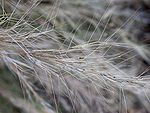
Threeawn, scientifically known as Aristida spp., is a group of grass species with a variety of uses and benefits in agriculture and ecology. These grasses are commonly found in dry and semi-arid regions around the world, and they possess several noteworthy characteristics that make them valuable.
Here’s an in-depth exploration of the uses and benefits of Threeawn grass;
1. Erosion Control: Threeawn grasses are excellent for erosion control, especially in arid and semi-arid regions. Their deep, fibrous root systems help bind soil particles together, preventing soil erosion caused by wind and water runoff. This makes them crucial for stabilizing fragile soils and conserving topsoil.
2. Drought Tolerance: One of the most significant advantages of Threeawn grasses is their exceptional drought tolerance. These grasses have adapted to thrive in arid conditions, making them valuable for areas with limited water resources. They can persist during extended dry spells when other grasses might wither.
3. Wildlife Habitat: Threeawn grasses serve as vital habitats for various wildlife species. Birds, insects, and small mammals find shelter and nesting sites within the dense foliage. The seeds of Threeawn grasses are also a source of food for birds and other wildlife.
4. Soil Improvement: The root systems of Threeawn grasses enhance soil structure and fertility. They improve aeration, water infiltration, and nutrient cycling, making the soil more suitable for other plant growth. In agricultural and restoration projects, Threeawn grasses are used to improve soil health.
5. Biodiversity Conservation: Threeawn grasses support biodiversity by providing critical ecological niches in arid environments. They promote a balanced ecosystem by offering a diverse range of resources, such as food, shelter, and breeding grounds, for various species.
6. Weed Suppression: In agricultural settings, Threeawn grasses can be strategically planted to help suppress the growth of unwanted weeds. Their dense growth and competitive nature reduce the availability of resources for weed establishment.
7. Grazing and Forage: Some Threeawn species have limited value as forage for livestock, especially in dry regions where other forage options are scarce. While not a primary forage choice, they can supplement grazing resources during periods of drought.
8. Soil Erosion Prevention: In addition to erosion control, Threeawn grasses help prevent soil erosion by stabilizing sand dunes in desert regions. Their extensive root systems play a crucial role in maintaining the integrity of dune structures.
9. Erosion on Construction Sites: Threeawn grasses are sometimes used on construction sites to control erosion until permanent vegetation can be established. Their rapid establishment and robust root systems are particularly beneficial in these applications.
10. Erosion Control in Landscaping: In landscaping, Threeawn grasses can be employed in xeriscaping or other environmentally friendly designs to control erosion on slopes and add aesthetic value to the landscape.
Threeawn grasses, with their adaptability to arid conditions and ecological benefits, offer a range of uses and advantages in agriculture, landscaping, and ecology.
Their role in erosion control, drought tolerance, wildlife habitat, and soil improvement makes them a valuable asset in promoting sustainable land management and conservation efforts, particularly in regions with limited water resources.
Frequently Asked Questions About Threeawn Grass (Aristida Spp.)
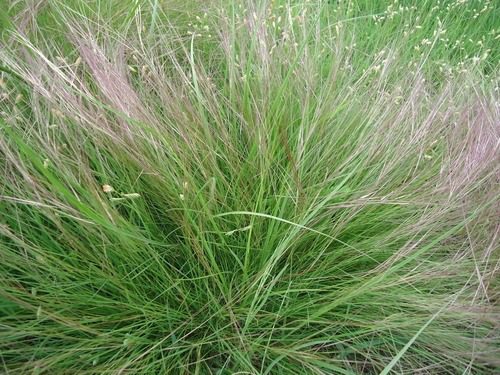
Threeawn, a common name for plants belonging to the Aristida genus, encompasses a group of grasses found in various regions around the world. These grasses are known for their distinctive seed heads and adaptability to different climates.
Here are frequently asked questions (FAQs) about Threeawn (Aristida spp.) along with detailed answers;
1. What is Threeawn, and what are its distinguishing features?
Threeawn, or Aristida, is a genus of grasses characterized by its unique seed heads, which consist of three long, bristle-like awns attached to each seed. These awns make the seed heads appear feathery and are distinctive to Threeawn plants.
2. Where can Threeawn grasses be found in the wild?
Threeawn grasses are widely distributed and can be found in a variety of ecosystems, including grasslands, savannas, deserts, and prairies. They are particularly common in arid and semi-arid regions.
3. Are there different species of Threeawn, and how can they be identified?
Yes, the Aristida genus comprises numerous species, and identification can be challenging due to the subtle differences between them. Typically, botanists use a combination of factors such as seed head structure, leaf shape, and habitat preferences for accurate identification.
4. What are the ecological benefits of Threeawn grasses?
Threeawn grasses play a crucial ecological role in providing forage for wildlife and livestock. They also contribute to soil stabilization, erosion control, and habitat for insects and other small organisms.
5. Can Threeawn grasses be used for landscaping and gardening?
While some Threeawn species have been utilized in xeriscaping and native landscaping, their use is limited due to their tendency to self-sow prolifically, which can lead to invasiveness in certain environments.
6. How can Threeawn grasses be cultivated in gardens or natural settings?
If you wish to grow Threeawn grasses in your garden, choose species that are native to your region and adapt to your local climate and soil conditions. Plant them from seeds in well-drained soil and provide regular watering until they establish themselves.
7. Are there any challenges in managing Threeawn grasses in a garden setting?
Yes, the prolific seeding of some Threeawn species can be challenging to manage in a garden, as they can become weedy. Frequent pruning or removing seed heads before they mature can help control their spread.
8. Can Threeawn grasses be used for erosion control in landscaping projects?
Yes, some Threeawn species are suitable for erosion control and soil stabilization, particularly in arid or semi-arid regions. Their deep root systems help anchor soil and prevent erosion.
9. Are there any pest or disease issues associated with Threeawn grasses?
Threeawn grasses are generally resistant to most pests and diseases. However, in some cases, they can be vulnerable to certain types of stem-boring insects.
10. Can Threeawn grasses be used as a source of forage for livestock?
Yes, some Threeawn species can provide forage for livestock, but their nutritional value can vary. Before using them as a forage source, it’s essential to ensure that the specific species are safe and provide adequate nutrition for the intended livestock.
In summary, Threeawn (Aristida spp.) is a diverse group of grasses known for their unique seed head structure. They have ecological benefits in natural settings, but their use in landscaping and gardening requires careful consideration due to their potential for invasiveness.
Proper species selection, suitable planting techniques, and prudent management are essential when incorporating Threeawn grasses into your landscape.
Read Also: TraxNYC Financing: Unlocking the World of Luxury Jewelry Acquisition

